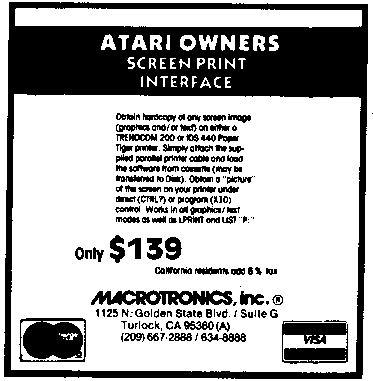are represented in the format known as hexadecimal notation or hex for short. While decimal numbers are represented by the digits 0-9, hex numbers have 16 combinations. The possible hex digits are 0-9 and A-F. So our JSR and STA from the description on mnemonics which were represented in decimal as 32 and 141, become 20 and 8D. The second is an Assembly language version of the first. Notice how much easier it is to comprehend what is going on over the machine coded version. This program will run a thousand times faster than BASIC doing the same thing.
Machine code example:A5 01 18 65 02 85 03
Assembly language example:
LDA 1 ;LOAD LOCATION 1
CMC CLEAR CARRY BIT
ADC 2 ADD IN LOCATION 2
STA 3 PUT IN LOCATION 3
A5 01 LDA 1 ; LOAD LOCATION 1
18 CMC ;CLEAR CARRY BIT
65 02 ADC 2 ADD IN LOCATION 2
85 03 STA 3 PUT IN LOCATION 3
The language PILOT will be available along with the ASSEMBLER cartridge this year. PILOT is what is known as an instructional language. It is used for teaching many subjects in both high school and college. It is essentially a question and answer language. PILOT asks questions of a student, accepts answers, checks if the answers are correct, and informs the student. It can then either ask the same question again or go on to another. An example might be to ask you to name a computer language mentioned in this article and then check to see if you were paying attention.
PILOT example:
*STRT
T : NAME A LANGUAGE THAT STARTS WITH
"P"
A :
M: PILOT, PASCAL
Y: VERY GOOD. YOU ARE RIGHT.
N: YOU WEREN'T LISTENING. TRY AGAIN.
JN: *STRT
The last language that I know is due from ATARI is Pascal. This is currently my favorite language, with ASSEMBLY coming in a close second (I go crazy over fast execution speeds). Pascal is a very exact language. All variables must be defined in the program. It is also harder to learn than BASIC. But once you have this language mastered, you will be able to think in Pascal. It is usually referred to as a structured language. This means among other things that it is a GOTOless language. While GOTO statements are allowed in some cases, heavy dependence is a sign of poor programming. It is possible to write large and intricate Pascal programs without using a GOTO statement even once. Another plus factor in favor of the language is that it executes up to five times faster than a BASIC program doing the exact same thing.
Pascal example:PROGRAM DEMO;
VAR
X,Y,Z,SUM:INTEGER;
BEGIN
(*REPEAT UNTIL SUM = 0
REPEAT
WRITE ('ENTER THREE NUMBERS?');
READLN(X,Y,Z);
SUM:= X+Y+Z;
WRITELN ('THE SUM IS',SUM)
UNTIL SUM = 0
END.
An article for a computer magazine is a very easy thing to write. In only a couple of days you are on your way to fame and fortune. Well maybe not fortune, but just think of how proud you will be when after hours of trying to explain to your Aunt and Uncle, why you bought the computer in the first place, you produce the issue of ANALOG that contains the article that took you three whole weeks to write and show it to them. They will be so impressed that your ideas were accepted for printing that they will just have to take you seriously from then on. So compose that article or write that program. It does not matter if you think it was done before. This is a new publication, with a new readership. These people haven't heard it before. And it doesn't matter if your spelling is terrible. These articles are proofread before being printed. It will be fixed up. If your ideas are important to you, they are important to us, and are worth printing. All it takes is a pen and paper.
